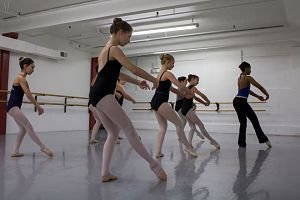Very often as teachers, we get to a point in our educating that we are so subconsciously determined to ensure a dancer’s comprehension that we ourselves forget it is up to them to do the learning. There have been times in my own teaching where I notice my habits creeping in that make me stop and wonder; “Is this approach to teaching really helping my students or am I inadvertently spoon-feeding and giving them all the answers?”
Always with the best of intentions, we want our students to be mindful, comprehend the lessons both kinesthetically and mentally and pick up things with deft and intricacy. However, that is not always the case. We all have our own teaching style and way we in which we deliver the content of our classes. We move, speak, use tactile correction, count, vocalize and clap rhythms, deconstruct choreography, discuss mechanics and initiation of movement, etc., etc. But what is our instinctual reaction when we see they are not picking things up the way they ought to be? At times, my own reaction has been to call out what’s coming next, get up and do it with them, give them the counts or supply them with the answer to my question if I see those puzzled looks on their faces that they don’t have a clue. But, do I really allot them sufficient time to think for a second or let them make the mistake and figure out how to self-correct and self-assess? How long is too long? Is it my own worry of my teaching abilities that makes me wonder what am I missing or not doing in terms of why the dancers don’t gel with the material? This is an important part of teaching to be aware of; and took me many years to learn; to check in with myself and learn new teaching habits to guide students but not do the work for them.
If you compare teaching with parenting, the principles are pretty much the same. It does not benefit one’s child at all when the parent does everything for them, protects them so much that they are shielded so intently they never learn to think for themselves or how to interact with others or how to fail. Again, all the best intentions, but by enabling that they don’t need to learn to think for themselves or figure out the ways of the world, we are in actuality, setting them up for failure, not success.
Same goes for teaching; there is a very fine line between providing the lessons and the materials necessary for them to develop and progress and doing the work for them. As a teacher it’s not only the dance content which is invaluable. It is those lessons within the lessons. Furthermore, if you are a teacher who habitually spoon-feeds information a little too frequently, students will figure that out quick enough that you will be there to rely on to follow instead of learn for themselves. The trick is to find the balance of identifying when the students REALLY need you to step in and demonstrate or repeat yourself or give them the answer. But…don’t be so quick to jump in without giving them sufficient time to think for themselves; even if they make a mistake or blank out for a moment. In truth, 9 times out of 10, they will re-center and figure it out on their own. Being a good and effective teacher is knowing when a student needs you to intervene and when to let the lessons be learned!
Good Luck!
See you in the dance studio,
Jessie

